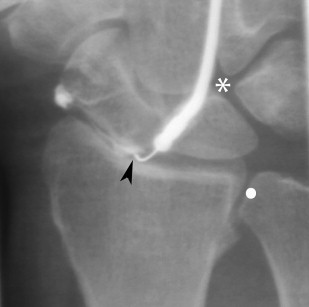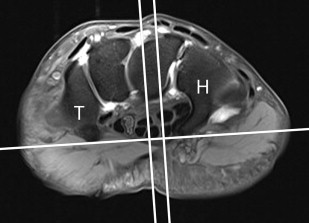Magnetic resonance (MR) arthrography of the wrist and elbow is useful for detecting a variety of intra-articular pathologies. MR dictations should address whether intrinsic ligament tears of the wrist are partial-thickness or full-thickness, and involve the dorsal, membranous, and/or volar components of the ligaments. With regard to elbow soft tissue pathology, partial-thickness tears of the anterior band of the ulnar collateral ligament in overhead-throwing athletes are well evaluated with MR arthrography. MR arthrography also is helpful in staging osteochondritis dissecans of the capitellum, caused by repetitive valgus impaction injury in adolescent or young adult baseball pitchers.
Key points
- •
Magnetic resonance (MR) arthrography is highly sensitive and specific for the diagnosis of scapholunate ligament tears.
- •
MR dictations should state if tears are partial-thickness or full-thickness, and if the tearing involves the dorsal, membranous, and/or volar components of the ligament.
- •
Partial-thickness tears of the anterior band of the ulnar collateral ligament in overhead-throwing athletes are well evaluated with MR arthrography.
- •
Repetitive valgus elbow stress and rapid elbow extension during the late stages of throwing may result in an olecranon stress fracture, with propagation from a structural weak point in the trochlear groove.
- •
Osteochondritis dissecans of the elbow is an osteochondral injury classically seen in adolescent or young adult athletes, especially baseball pitchers, due to repetitive valgus impaction injury of the radial head and developing ossification center of the capitellum.
Magnetic resonance arthrography of the wrist
Wrist pain is a common, nonspecific patient complaint that may be secondary to a variety of underlying processes, both degenerative and traumatic. Wrist trauma can be divided into 2 categories: low impact and high impact. High-impact trauma can lead to displaced fractures, dislocations, and acute tears of the ligaments and tendons, whereas low-impact trauma can lead to more occult injuries. Both mechanisms can result in injuries to the intrinsic and extrinsic carpal ligaments, as well as the triangular fibrocartilage complex (TFCC). Because the TFC is discussed in depth in the article by Cody et al, elsewhere in this issue, this article will not focus on its normal imaging appearance or pathology. Because clinical presentations can overlap significantly, magnetic resonance (MR) arthrography is essential in the diagnostic workup of such injuries. MR arthrography of the wrist is generally preferred over conventional MR imaging or computed tomography (CT) arthrography because of its high intrinsic contrast resolution, as well as the ability to evaluate extra-articular soft tissue pathology. MR arthrography is indicated to evaluate TFCC, intrinsic and extrinsic carpal ligaments, and the distal radial ulnar joint (DRUJ).
Technique
The use of intra-articular contrast agents provides an effective means of evaluating the TFCC and interosseous ligaments of the wrist. There is variability among institutions as to whether to perform single-compartment (most commonly radiocarpal), 2-compartment, or rarely 3-compartment (radiocarpal, DRUJ, and midcarpal) arthrography before MR arthrography. Injections are most commonly performed under fluoroscopic guidance, but some radiologists prefer sonographic guidance. Radiocarpal injections are approached most commonly from a dorsal approach; however, some radiologists choose a lateral approach. With the patient supine on the fluoroscopy table, the patient’s wrist is placed in a flexed position and bolstered with a rolled towel. The radiocarpal joint is visualized in profile and the skin overlying the joint is marked at the level of the mid scaphoid. After prepping and draping the dorsum of the wrist, local anesthesia is administered with a 25-gauge, 1.5-inch anesthesia needle from a dorsal approach, and the needle is advanced into the radiocarpal joint. Connector tubing flushed with injectate from the syringe is connected to the needle after dripping contrast into the needle hub to displace any air. Although some radiologists inject only a small amount of iodinated contrast to confirm needle placement before injecting the dilute gadolinium mixture, it is also acceptable to combine the iodinate contrast and gadolinium together. While taking rapid cine images, an approximately 3-mL mixture of iodinated contrast and dilute gadolinium is injected into the radiocarpal joint, or until resistance is perceived ( Fig. 1 ). The gadolinium-based contrast used in MR arthrography is usually diluted in normal saline and/or iodinated contrast to a concentration of 1:250, which optimizes the paramagnetic effects of gadolinium at 1.5-T field strengths. After removal of the needle, the wrist is then briefly exercised and conventional arthrographic images are obtained in the anteroposterior, lateral, and oblique images before MR arthrography. Some radiologists also prefer taking dedicated spot imaging of the scapholunate (SL) ligament with ulnar deviation or clenched fist stress maneuver. This arthrographic imaging is diagnostic, and is instrumental in cases of patients unable to complete the MR portion of the examination for a variety of reasons.

Midcarpal joint injections are most commonly performed from a dorsal approach into to the central portion of the 4-part junction of the lunate, triquetrum, hamate, and capitate. Distal radioulnar joint injection is performed from a dorsal approach, with the needle extending to the radial aspect of the ulnar head.
Contraindications
Besides the normal contraindications for MR imaging, the only absolute contraindication for arthrography is local infection of the skin or subcutaneous tissue. One would not want to contaminate a joint by crossing a needle through infected tissues. Usually, patients who cannot undergo MR arthrography are able to tolerate imaging with CT arthrography. For example, patients with implantable cardiac pacemakers who, with some recent exceptions due to new MR imaging-safe pacemakers, cannot undergo MR arthrography, can be safely evaluated with CT. A history of adverse contrast reactions with either iodinated or gadolinium-based agents is considered a relative contraindication and should be evaluated on a case-by-case basis.
Complications
Arthrography is a generally well-tolerated procedure with few significant risks, and complications following arthrography are uncommon and usually in the form of pain. This can be due to overdistention of the joint space, irritation of surrounding nerves, or from intravasation of injected contrast into adjacent muscles. Synovitis caused by the contrast also may be irritating and painful. Infection is an inherent risk to all percutaneous procedures, but is very rare.
Magnetic Resonance Acquisition
Wrist MR arthrography should be obtained on a 1.5-T or preferably a 3.0-T magnet in a dedicated wrist coil for optimal image quality, and thin-section imaging and small field of view should be used ( Table 1 ). Patients are optimally scanned in the prone position with the arm extended overhead and the wrist in neutral positioning near the isocenter of the magnet (“Superman” position). If patients cannot tolerate this positioning, imaging is done with the wrist by the patient’s side, with care to optimize fat suppression. MR arthrography includes axial, coronal, and sagittal imaging planes, and the coronal and sagittal sequences are prescribed relative to a plane intersecting the hook of the hamate and the palmar margin of the trapezium ( Fig. 2 ). Most sequences are obtained with turbo spin echo (TSE) T1-weighting with fat suppression, to take advantage of the T1 properties of the injected gadolinium; T1-weighted images without fat suppression and T2-weighted images with fat suppression also are obtained. T2-weighted fat-suppressed and non–fat-suppressed T1-weighted images are useful in evaluating the marrow. T2-weighted images can detect noncommunicating tears of the intrinsic ligaments and TFCC on the opposite side of the injected joint, marrow edema, and noncommunicating periarticular fluid collections. Some centers also prefer using gradient-echo sequences or 3-dimensional volumetric sequences. Although uncommonly used, some investigators use finger trap distraction with weights suspended from the fingers to accentuate the amount of contrast in the SL interval, widening of the space, and disruption of Gilula carpal arcs.
| Plane | Sequence | FOV, cm | Slice Thickness, mm |
|---|---|---|---|
| Axial | TSE T1 FS | 15 | 3 |
| Coronal | TSE T1 FS | 15 | 2 |
| Sagittal | TSE T1 FS | 15 | 3 |
| Coronal | TSE T2 FS | 15 | 2 |
| Coronal | TSE T1 | 15 | 2 |

Magnetic resonance arthrography of the wrist
Wrist pain is a common, nonspecific patient complaint that may be secondary to a variety of underlying processes, both degenerative and traumatic. Wrist trauma can be divided into 2 categories: low impact and high impact. High-impact trauma can lead to displaced fractures, dislocations, and acute tears of the ligaments and tendons, whereas low-impact trauma can lead to more occult injuries. Both mechanisms can result in injuries to the intrinsic and extrinsic carpal ligaments, as well as the triangular fibrocartilage complex (TFCC). Because the TFC is discussed in depth in the article by Cody et al, elsewhere in this issue, this article will not focus on its normal imaging appearance or pathology. Because clinical presentations can overlap significantly, magnetic resonance (MR) arthrography is essential in the diagnostic workup of such injuries. MR arthrography of the wrist is generally preferred over conventional MR imaging or computed tomography (CT) arthrography because of its high intrinsic contrast resolution, as well as the ability to evaluate extra-articular soft tissue pathology. MR arthrography is indicated to evaluate TFCC, intrinsic and extrinsic carpal ligaments, and the distal radial ulnar joint (DRUJ).
Technique
The use of intra-articular contrast agents provides an effective means of evaluating the TFCC and interosseous ligaments of the wrist. There is variability among institutions as to whether to perform single-compartment (most commonly radiocarpal), 2-compartment, or rarely 3-compartment (radiocarpal, DRUJ, and midcarpal) arthrography before MR arthrography. Injections are most commonly performed under fluoroscopic guidance, but some radiologists prefer sonographic guidance. Radiocarpal injections are approached most commonly from a dorsal approach; however, some radiologists choose a lateral approach. With the patient supine on the fluoroscopy table, the patient’s wrist is placed in a flexed position and bolstered with a rolled towel. The radiocarpal joint is visualized in profile and the skin overlying the joint is marked at the level of the mid scaphoid. After prepping and draping the dorsum of the wrist, local anesthesia is administered with a 25-gauge, 1.5-inch anesthesia needle from a dorsal approach, and the needle is advanced into the radiocarpal joint. Connector tubing flushed with injectate from the syringe is connected to the needle after dripping contrast into the needle hub to displace any air. Although some radiologists inject only a small amount of iodinated contrast to confirm needle placement before injecting the dilute gadolinium mixture, it is also acceptable to combine the iodinate contrast and gadolinium together. While taking rapid cine images, an approximately 3-mL mixture of iodinated contrast and dilute gadolinium is injected into the radiocarpal joint, or until resistance is perceived ( Fig. 1 ). The gadolinium-based contrast used in MR arthrography is usually diluted in normal saline and/or iodinated contrast to a concentration of 1:250, which optimizes the paramagnetic effects of gadolinium at 1.5-T field strengths. After removal of the needle, the wrist is then briefly exercised and conventional arthrographic images are obtained in the anteroposterior, lateral, and oblique images before MR arthrography. Some radiologists also prefer taking dedicated spot imaging of the scapholunate (SL) ligament with ulnar deviation or clenched fist stress maneuver. This arthrographic imaging is diagnostic, and is instrumental in cases of patients unable to complete the MR portion of the examination for a variety of reasons.
Midcarpal joint injections are most commonly performed from a dorsal approach into to the central portion of the 4-part junction of the lunate, triquetrum, hamate, and capitate. Distal radioulnar joint injection is performed from a dorsal approach, with the needle extending to the radial aspect of the ulnar head.
Contraindications
Besides the normal contraindications for MR imaging, the only absolute contraindication for arthrography is local infection of the skin or subcutaneous tissue. One would not want to contaminate a joint by crossing a needle through infected tissues. Usually, patients who cannot undergo MR arthrography are able to tolerate imaging with CT arthrography. For example, patients with implantable cardiac pacemakers who, with some recent exceptions due to new MR imaging-safe pacemakers, cannot undergo MR arthrography, can be safely evaluated with CT. A history of adverse contrast reactions with either iodinated or gadolinium-based agents is considered a relative contraindication and should be evaluated on a case-by-case basis.
Complications
Arthrography is a generally well-tolerated procedure with few significant risks, and complications following arthrography are uncommon and usually in the form of pain. This can be due to overdistention of the joint space, irritation of surrounding nerves, or from intravasation of injected contrast into adjacent muscles. Synovitis caused by the contrast also may be irritating and painful. Infection is an inherent risk to all percutaneous procedures, but is very rare.
Magnetic Resonance Acquisition
Wrist MR arthrography should be obtained on a 1.5-T or preferably a 3.0-T magnet in a dedicated wrist coil for optimal image quality, and thin-section imaging and small field of view should be used ( Table 1 ). Patients are optimally scanned in the prone position with the arm extended overhead and the wrist in neutral positioning near the isocenter of the magnet (“Superman” position). If patients cannot tolerate this positioning, imaging is done with the wrist by the patient’s side, with care to optimize fat suppression. MR arthrography includes axial, coronal, and sagittal imaging planes, and the coronal and sagittal sequences are prescribed relative to a plane intersecting the hook of the hamate and the palmar margin of the trapezium ( Fig. 2 ). Most sequences are obtained with turbo spin echo (TSE) T1-weighting with fat suppression, to take advantage of the T1 properties of the injected gadolinium; T1-weighted images without fat suppression and T2-weighted images with fat suppression also are obtained. T2-weighted fat-suppressed and non–fat-suppressed T1-weighted images are useful in evaluating the marrow. T2-weighted images can detect noncommunicating tears of the intrinsic ligaments and TFCC on the opposite side of the injected joint, marrow edema, and noncommunicating periarticular fluid collections. Some centers also prefer using gradient-echo sequences or 3-dimensional volumetric sequences. Although uncommonly used, some investigators use finger trap distraction with weights suspended from the fingers to accentuate the amount of contrast in the SL interval, widening of the space, and disruption of Gilula carpal arcs.
| Plane | Sequence | FOV, cm | Slice Thickness, mm |
|---|---|---|---|
| Axial | TSE T1 FS | 15 | 3 |
| Coronal | TSE T1 FS | 15 | 2 |
| Sagittal | TSE T1 FS | 15 | 3 |
| Coronal | TSE T2 FS | 15 | 2 |
| Coronal | TSE T1 | 15 | 2 |
Normal anatomy
Intrinsic Ligaments
The intrinsic and extrinsic interosseous ligaments of the wrist provide stability to the carpus. The SL ligament is the most commonly injured intrinsic carpal ligament and can predispose to carpal instability. Patients with ligamentous injury typically present with dorsal wrist pain, crepitus with motion, weakness, and swelling. The SL ligament consists of the bandlike dorsal and volar components connected by the membranous portion composed of a proximal fibrocartilaginous membrane; the dorsal component is considered the primary SL stabilizer ( Fig. 3 ). The lunotriquetral (LT) ligament is similar in composition to the SL ligament; however, the volar rather than the dorsal component is considered the primary stabilizer of the LT ligament. These ligaments provide a barrier between the radiocarpal and midcarpal spaces. CT and MR arthrography have been shown to be more sensitive than standard MR for detecting abnormalities of these ligaments, and MR is superior to CT in detecting other causes of patient’s symptoms, such as osteonecrosis, tendon and tendon sheath pathology, synovitis, fluid collections, and masses.
Extrinsic Ligaments
The extrinsic ligaments of the wrist are shown to better advantage with MR arthrography due to joint distention. Dorsally, the extrinsic ligaments are the dorsal radiocarpal ligament (DRCL) and the dorsal intercarpal ligament (DICL) ( Fig. 4 ). These ligaments generally demonstrate homogeneously low signal intensity on MR imaging. Volar extrinsic ligaments include the radioscaphocapitate ligament (RSCL), radiolunotriquetral ligament (RLTL, also known as the long radiolunate ligament), and the short radiolunate ligament. The RSCL is the most important volar extrinsic ligament, and the RSCL and RLTL can contain normal bands of higher signal on MR imaging/MR arthrography. The radial collateral ligament (RCL) of the wrist arises as a focal condensation of the joint capsule, just deep to the extensor tendon sheath; it originates from the radial styloid and inserts onto the scaphoid waist. Carpal instability may occur when there is concomitant injury to the intrinsic and extrinsic interosseous ligaments.







